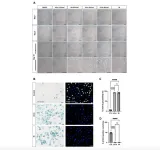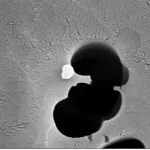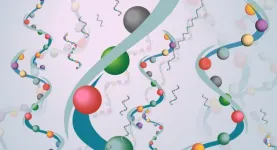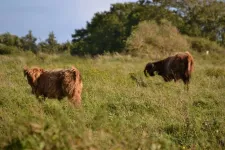(Press-News.org) Around 6,200 BCE, the climate changed. Global temperatures dropped, sea levels rose and the southern Levant, including modern-day Israel, the Palestinian territories, Jordan, Lebanon, southern Syria and the Sinai desert, entered a period of drought.
Previously, archaeologists believed that this abrupt shift in global climate, called the 8.2ka event, may have led to the widespread abandonment of coastal settlements in the southern Levant. In a recent study published with the journal Antiquity, researchers at UC San Diego, the University of Haifa and Bar-Ilan University share new evidence suggesting at least one village formerly thought abandoned not only remained occupied, but thrived throughout this period.
“This [study] helped fill a gap in our understanding of the early settlement of the Eastern Mediterranean coastline,” said Thomas Levy, a co-author on the paper, co-director of the Center for Cyber-Archaeology and Sustainability (CCAS) at the UC San Diego Qualcomm Institute (QI), inaugural holder of the Norma Kershaw Chair in the Archaeology of Ancient Israel and Neighboring Lands in the Department of Anthropology, and a distinguished professor in the university’s Graduate Division. “It deals with human resilience.”
Signs of Life
The village of Habonim North was discovered off Israel’s Carmel Coast in the mid-2010s and later surveyed by a team led by the University of Haifa’s Ehud Arkin Shalev.
Prior to its excavation and analysis, there was scant evidence for human habitation along the southern Levantine coast during the 8.2ka event. The dig, which took place during the COVID-19 lockdown and involved a weeks-long, 24/7 coordinated effort between partners at UC San Diego and the University of Haifa, was the first formal excavation of the submerged site.
Led by Assaf Yasur-Landau, head of the Leon Recanati Institute for Maritime Studies at the University of Haifa, and Roey Nickelsberg, a Ph.D. candidate at the University of Haifa, the international team excavated the site using a combination of sediment dredging and sampling, as well as photogrammetry and 3D modeling. Team members uncovered pottery shards or “sherds”; stone tools, including ceremonial weapons and fishing-net weights; animal and plant remains; and architecture.
Using radiocarbon dating, the researchers tested the recovered bones of wild and domesticated animals; the charred seeds of wild plants; crops like wheat and lentils; and weeds that tend to accompany these crops. Their results traced these organic materials back to the Early Pottery Neolithic (EPN), which coincided with both the invention of pottery and the 8.2ka event.
Habonim North’s pottery sherds, stone tools and architecture likewise dated activity at the site to the EPN and, surprisingly, to the Late Pottery Neolithic, when the village was thought to have been abandoned.
As for how the village likely weathered the worst of the climate instability, the researchers point to signs of an economy that diversified from farming to include maritime culture and trade within a distinct cultural identity. Evidence includes fishing-net weights; tools made of basalt, a stone that does not naturally occur along this part of the eastern Mediterranean coast; and a ceremonial mace head.
“[Our study] showed that the Early Pottery Neolithic society [at Habonim North] displayed multi-layered resilience that enabled it to withstand the 8.2ka crisis,” said Assaf Yasur-Landau, senior author on the paper. “I was happily surprised by the richness of the finds, from pottery to organic remains.”
Through 3D “digital twin” technology and the Haifa – UC San Diego QI collaboration, the researchers studying Habonim North have been able to recreate their excavation, virtually, and 3D-print artifacts, opening the path to further study. The team previously received an Innovations in Networking Award for Research Applications from the non-profit organization CENIC for “exemplary” work leveraging high-bandwidth networking during the COVID-19 pandemic.
Shifting the Focus to Resilience
Although scientists debate the cause of the 8.2ka event, some speculate that it began with the final collapse of the Laurentide ice sheet, which shaped much of the North American landscape in its retreat from modern-day Canada and the Northern United States.
As it melted, the ice sheet would have changed the flow of ocean currents, affecting heat transport and leading to the observed drop in global temperatures.
For the authors behind the study, the discovery of lasting and evolving social activity at Habonim North through this period of climate instability indicates a level of resilience in early Neolithic societies. Many of the activities uncovered at the village, including the creation of culturally distinct pottery and trade, formed the basis for later urban societies.
“To me, what’s important is to change how we look at things,” said Nickelsberg. “Many archaeologists like to look at the collapse of civilizations. Maybe it’s time to start looking at the development of human culture, rather than its destruction and abandonment.”
END
Scientists show ancient village adapted to drought, rising seas
Underwater excavation reveals human resilience through Neolithic-period climate change
2024-04-30
ELSE PRESS RELEASES FROM THIS DATE:
Cover paper: Senescent characteristics of human corneal endothelial cells upon UV-A exposure
2024-04-30
“[...] these findings may help to advance our understanding of the pathogenesis of corneal endothelial disease and may lead to the discovery of new therapies targeting senescent cells.”
BUFFALO, NY- April 30, 2024 – A new research paper was published on the cover of Aging (listed by MEDLINE/PubMed as "Aging (Albany NY)" and "Aging-US" by Web of Science) Volume 16, Issue 8, entitled, “Senescent characteristics of human corneal endothelial cells upon ultraviolet-A exposure.”
In ...
Activity in a room stirs up nanoparticles left over from consumer sprays
2024-04-30
Common household products containing nanoparticles – grains of engineered material so miniscule they are invisible to the eye – could be contributing to a new form of indoor air pollution, according to a Rutgers study.
In a study published in the journal Science of the Total Environment, a team of Rutgers researchers found people walking through a space, where a consumer product containing nanoparticles was recently sprayed, stirred residual specks off carpet fibers and floor surfaces, projecting them some three ...
NASA’s Webb maps weather on planet 280 light-years away
2024-04-30
An international team of researchers has successfully used NASA’s James Webb Space Telescope to map the weather on the hot gas-giant exoplanet WASP-43 b.
Precise brightness measurements over a broad spectrum of mid-infrared light, combined with 3D climate models and previous observations from other telescopes, suggest the presence of thick, high clouds covering the nightside, clear skies on the dayside, and equatorial winds upwards of 5,000 miles per hour mixing atmospheric gases around the planet.
The investigation is just the latest demonstration of the exoplanet science now possible with Webb’s ...
Webb captures top of iconic horsehead nebula in unprecedented detail
2024-04-30
NASA’s James Webb Space Telescope has captured the sharpest infrared images to date of a zoomed-in portion of one of the most distinctive objects in our skies, the Horsehead Nebula. These observations show the top of the “horse’s mane” or edge of this iconic nebula in a whole new light, capturing the region’s complexity with unprecedented spatial resolution.
Webb’s new images show part of the sky in the constellation Orion (The Hunter), in the western side of a dense region known as the Orion B molecular cloud. Rising from turbulent waves of dust and gas is the Horsehead Nebula, otherwise known as ...
Researchers reveal a new approach for treating degenerative diseases
2024-04-30
Proteins are the workhorses of life. Organisms use them as building blocks, receptors, processors, couriers and catalysts. A protein’s structure is critical to its function. Malformed proteins not only fail to carry out their tasks, they can accumulate and eventually gum up the inner workings of cells. As a result, misfolded proteins cause a variety of degenerative diseases, from Alzheimer’s and Parkinson’s to the blinding disease retinitis pigmentosa. These disorders are currently incurable.
A paper out of UC Santa Barbara reveals a new connection between ...
People who inject drugs are transitioning to smoking
2024-04-30
Researchers from the University of California San Diego have revealed new trends in drug consumption that shed light on how people are adapting to the evolving risks associated with unregulated drug use in the United States. The findings could help policymakers and public health officials better tailor interventions to meet the needs of vulnerable populations and reduce the public health burden of substance-related harm.
Since the early 2010s, deaths from accidental overdoses have been on the rise ...
AI speech analysis may aid in assessing and preventing potential suicides, says Concordia PhD candidate Alaa Nfissi
2024-04-30
Speech is critical to detecting suicidal ideation and a key to understanding the mental and emotional state of people experiencing it. Suicide hotline counsellors are trained to quickly analyze speech variation to better help callers through a crisis.
But just as no system is perfect, there is room for error in interpreting a caller’s speech. In order to assist hotline counsellors to properly assess a caller’s condition, Concordia PhD student Alaa Nfissi has developed a model for speech emotion recognition (SER) using artificial intelligence tools. The model analyzes and codes waveform modulations in ...
New clinical practice guideline provides evidence-based recommendations for Age-related Hearing Loss (ARHL)
2024-04-30
April 30, 2024, ALEXANDRIA, Virginia —The American Academy of Otolaryngology–Head and Neck Surgery Foundation (AAO-HNSF) published the Clinical Practice Guideline: Age-Related Hearing Loss today in Otolaryngology–Head and Neck Surgery. This clinical practice guideline (CPG) sheds lights on a global public health problem affecting approximately 466 million people worldwide and identifies quality improvement opportunities and provide clinicians trustworthy, evidence-based recommendations regarding the identification and management of age-related hearing loss (ARHL) in patients 50 years and older.
“Age-related ...
Low-intensity grazing is locally better for biodiversity but challenging for land users, a new study shows
2024-04-30
The grazing of both domestic and wild animals is shaping landscapes across Europe. It can also contribute to multiple ecosystem services, such as providing habitat for biodiversity. Grazing systems with lower densities of animals and with minimal and only targeted applications of deworming and other medicinal treatments offer benefits for local biodiversity protection and various ecosystem services. However, this type of land management also poses a range of challenges, leading to a constant decline in the number of land users engaged in low-intensity grazing. A team of researchers led by iDiv, UL, and UFZ set out to investigate these ...
An omega-6 fatty acid may reduce the risk for bipolar disorder
2024-04-30
Philadelphia, April 30, 2024 – A genetic propensity to higher circulating levels of lipids containing arachidonic acid, an omega-6 polyunsaturated fatty acid found in eggs, poultry, and seafood, has been found to be linked with a lower risk for bipolar disorder, according to a new study in Biological Psychiatry, published by Elsevier. This new evidence paves the way for potential lifestyle or dietary interventions.
Bipolar disorder is a debilitating mood disorder characterized by recurring episodes of mania and depression. Although its etiology is still unclear, previous studies have shown that ...
LAST 30 PRESS RELEASES:
Tracing the quick synthesis of an industrially important catalyst
New software sheds light on cancer’s hidden genetic networks
UT Health San Antonio awarded $3 million in CPRIT grants to bolster cancer research and prevention efforts in South Texas
Third symposium spotlights global challenge of new contaminants in China’s fight against pollution
From straw to soil harmony: International team reveals how biochar supercharges carbon-smart farming
Myeloma: How AI is redrawing the map of cancer care
Manhattan E. Charurat, Ph.D., MHS invested as the Homer and Martha Gudelsky Distinguished Professor in Medicine at the University of Maryland School of Medicine
Insilico Medicine’s Pharma.AI Q4 Winter Launch Recap: Revolutionizing drug discovery with cutting-edge AI innovations, accelerating the path to pharmaceutical superintelligence
Nanoplastics have diet-dependent impacts on digestive system health
Brain neuron death occurs throughout life and increases with age, a natural human protein drug may halt neuron death in Alzheimer’s disease
SPIE and CLP announce the recipients of the 2025 Advanced Photonics Young Innovator Award
Lessons from the Caldor Fire’s Christmas Valley ‘Miracle’
Ant societies rose by trading individual protection for collective power
Research reveals how ancient viral DNA shapes early embryonic development
A molecular gatekeeper that controls protein synthesis
New ‘cloaking device’ concept to shield sensitive tech from magnetic fields
Researchers show impact of mountain building and climate change on alpine biodiversity
Study models the transition from Neanderthals to modern humans in Europe
University of Phoenix College of Doctoral Studies releases white paper on AI-driven skilling to reduce burnout and restore worker autonomy
AIs fail at the game of visual “telephone”
The levers for a sustainable food system
Potential changes in US homelessness by ending federal support for housing first programs
Vulnerability of large language models to prompt injection when providing medical advice
Researchers develop new system for high-energy-density, long-life, multi-electron transfer bromine-based flow batteries
Ending federal support for housing first programs could increase U.S. homelessness by 5% in one year, new JAMA study finds
New research uncovers molecular ‘safety switch’ shielding cancers from immune attack
Bacteria resisting viral infection can still sink carbon to ocean floor
Younger biological age may increase depression risk in older women during COVID-19
Bharat Innovates 2026 National Basecamp Showcases India’s Most Promising Deep-Tech Ventures
Here’s what determines whether your income level rises or falls
[Press-News.org] Scientists show ancient village adapted to drought, rising seasUnderwater excavation reveals human resilience through Neolithic-period climate change





